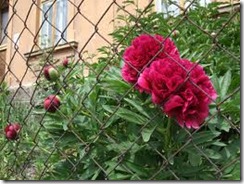Peonies have been cultivated for at least 2,000 years. A favorite of royalty in China, where the tree peony flower is associated with riches and honors, there are two main types of peonies grown in American gardens from hardiness zones 2 to 8. With proper care, both are long-lived. Peony hybrids are herbaceous perennials that grow 2 to 4 feet tall, producing large and often fragrant blossoms. Tree peonies are herbaceous shrubs delivering striking blooms with colors ranging from white to red.
History
-
Peonies are indigenous to Asia, Europe and North America. The peony flower appears throughout much of Chinese history, and the Greeks gave peonies its modern name. Romans spread the plants to England. In the United States, the peony was an early 20th century commercial floral industry success. It could be cut in bud, refrigerated a few weeks, then shipped by rail to distant markets.
Growing Requirements
-
Peony hybrids like sunny locations and well-drained soils with rich organic matter and a pH range of 6.5 to 7.5. Winter chill is required during dormancy, which is why peonies do not do well in warmer climates. Blooms last about a week, with the season extended to approximately six weeks by choosing varieties that bloom at different times. Tree peonies enjoy the same sunny locations and rich soil as hybrids. They are not as hardy as herbaceous peonies, and require deeper holes for their root systems.
Planting
-
Give each peony a space about 3 feet in diameter. Dig a hole slightly deeper than the plant roots and place the peony eyes (reddish buds above the root system) about 1 or 2 inches below the planting surface. Fill in with soil and water well. For potted peonies, when planting in the fall the goal is to help the root system grow and not have top growth. Place in an unheated covered space or top dress with mulch. For tree peonies, plant on 4-by-4-foot squares and avoid any standing water.
Peony Care
-
Peonies like little attention and not much fertilizer, other than periodic feeding. Over-fertilized plants do not bloom, especially when a plant gets too much nitrogen. Water needs are also not great. Apply moisture sparingly. Keep fertilizer away from plant roots and apply after flowers have bloomed. One to two handfuls of bone meal per plant is recommended. For tree peonies, the growers at Cricket Hill Garden in Connecticut suggest a weak fish-seaweed solution applied each 14 to 21 days, with no fertilization after leaves turn green.
Peony Colors
-
For centuries, growers have created peonies with more varied peonies on an expanding color palette. According to the extension service from The Ohio State University, herbaceous peony flowers can be almost any color, except blue. For tree peonies, colors shade from white to pink to red. Color tones trend to blue rather than dark red, some are double colored, and others have contrasting outer and inner blossom shades.


Deprecated: strpos(): Passing null to parameter #1 ($haystack) of type string is deprecated in /home/agriviek8Qv/agriviet.net/public_html/wp-includes/comment-template.php on line 2522